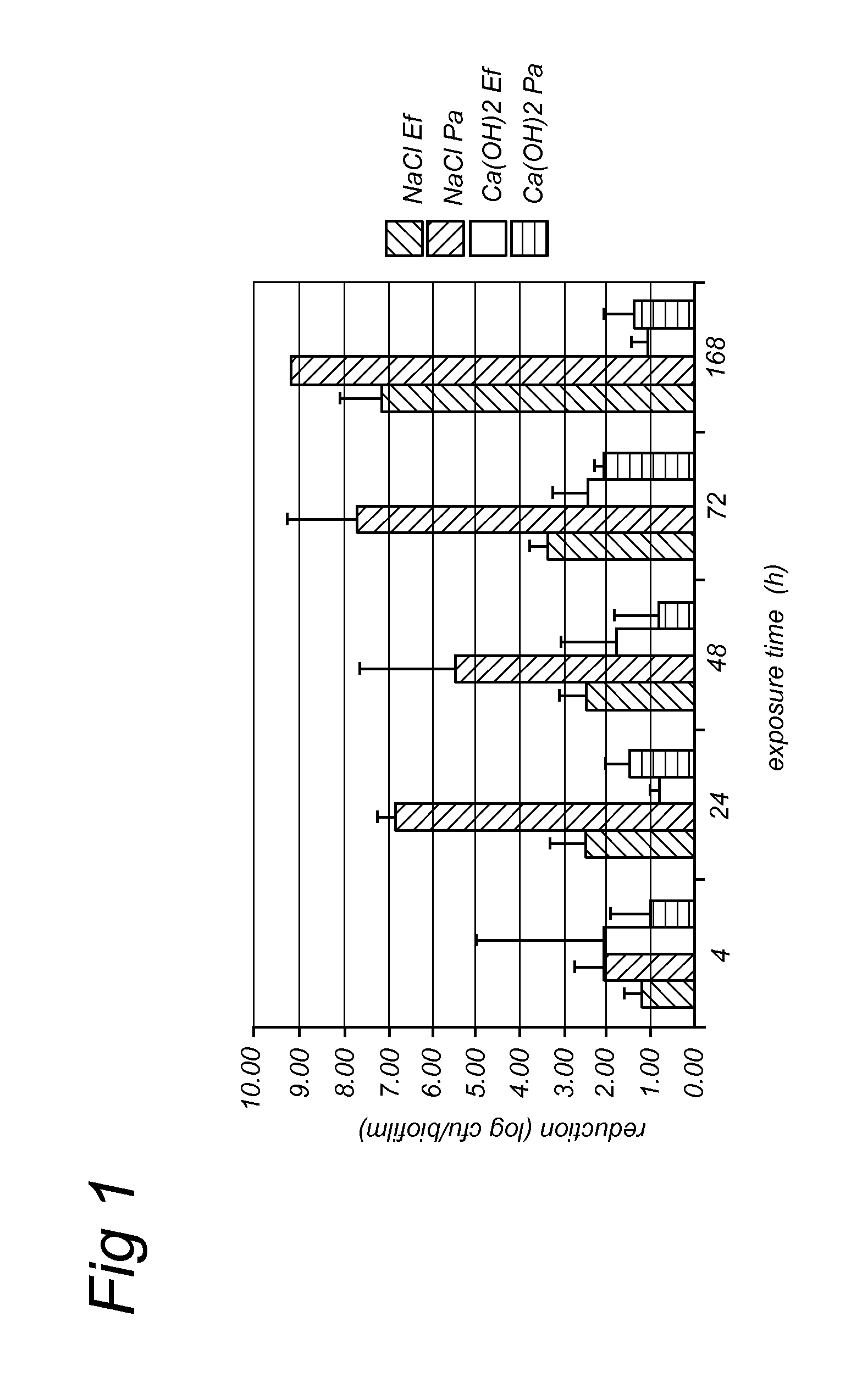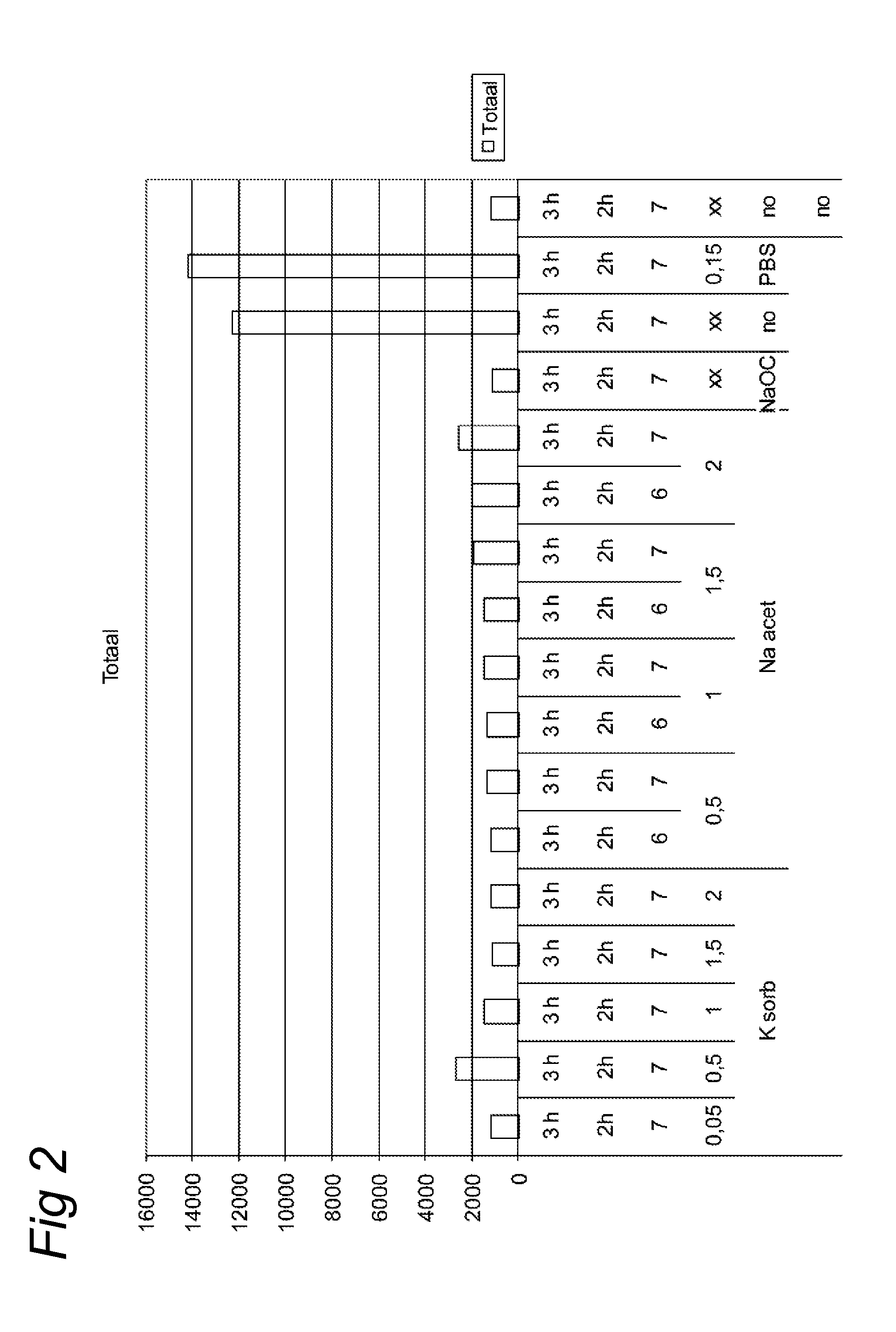Disinfectant composition and its use in dental treatment
a technology of disinfectant composition and antimicrobial composition, which is applied in the direction of drug composition, application, biocide, etc., can solve the problems of affecting the survival rate of dental tissue infections, the death of microorganisms, and the inability to withstand acidic stress,
- Summary
- Abstract
- Description
- Claims
- Application Information
AI Technical Summary
Benefits of technology
Problems solved by technology
Method used
Image
Examples
experiment 1
[0050]This experiment was performed to establish effectiveness of the compositions (experimental medicament or ‘EM’) of the present invention, using a 6.2 M NaCl solution, in root canal treatment and to compare its efficiency with calcium hydroxide (CH), which is currently the treatment of choice as already explained in the Background part of this document. Therefore the experimental set-up was to compare the bactericidal effect of EM with CH on a biofilm of Enterococcus faecalis and Pseudomonas aeruginosa.
Materials and Methods
[0051]The biofilm model used here was recently described by Deng et al. 2009. In brief, round glass cover slips attached to a custom made stainless steel lid, were suspended in medium inoculated with bacteria. In this model biofilm growth is an active process against gravity.
[0052]A dual-species biofilm was used because of its increased resistance to antimicrobials (Özok et al. 2007, Kara et al. 2007, Adrião et al. 2008). E. faecalis was chosen as the test or...
experiment 2
[0073]Weak acids have a pKa below 5. Weak acid stress can only be induced if the protonated, uncharged form of the acid diffuses into the cell. Therefore the pH of the medicament must be lower than the cellular pH. With a low pH, below 5.5, a lesser concentration of acid is needed than at a higher pH, where for the same efficacy the concentration must increase. But at pH 5.7 demineralization of dentin and enamel occurs.
[0074]A 6.2 M NaCl in broth solution proved to be bactericidal on a dual species biofilm. 108 and 107 reductions were reached after a week's exposure, resulting in eradication of one species (Experiment 1). It is assumed that a higher concentration of a hygroscopic salt will be more bactericidal resulting in quicker and more reliable eradication of all species, including E. faecalis. By imposing the bacteria with another added stress factor the efficacy will increase.
[0075]This leads to the development of an EM with a higher molarity and the development of an EM that ...
experiment 3
[0078]The purpose of this study is to investigate whether dentine has an inhibitory effect on the mode of action of the EM.
[0079]The antimicrobial efficacy of irrigating solutions and local disinfectants used in endodontics appears to be poorer in vivo than in vitro. There are several reasons for the lower in vivo performance, but clearly inactivation of the disinfectants by dentin and other substances present in the necrotic root canal is one factor contributing to the recognized difficulty in completely eradicating micro-organisms from the root canal system. Dentin chips have a buffering capacity in in vitro studies when added to the test tubes with microbes and antimicrobials. In this in vitro study overnight cultures of E. faecalis are exposed to the medicament with and without added dentin chips. After 24 h of incubation serial tenfold dilutions are made and cultured on bloodagar plates. The colonies are counted.
[0080]This leads to confirmation of the activity of the different ...
PUM
| Property | Measurement | Unit |
|---|---|---|
| Molar density | aaaaa | aaaaa |
| Tonicity | aaaaa | aaaaa |
Abstract
Description
Claims
Application Information
 Login to View More
Login to View More - R&D
- Intellectual Property
- Life Sciences
- Materials
- Tech Scout
- Unparalleled Data Quality
- Higher Quality Content
- 60% Fewer Hallucinations
Browse by: Latest US Patents, China's latest patents, Technical Efficacy Thesaurus, Application Domain, Technology Topic, Popular Technical Reports.
© 2025 PatSnap. All rights reserved.Legal|Privacy policy|Modern Slavery Act Transparency Statement|Sitemap|About US| Contact US: help@patsnap.com


